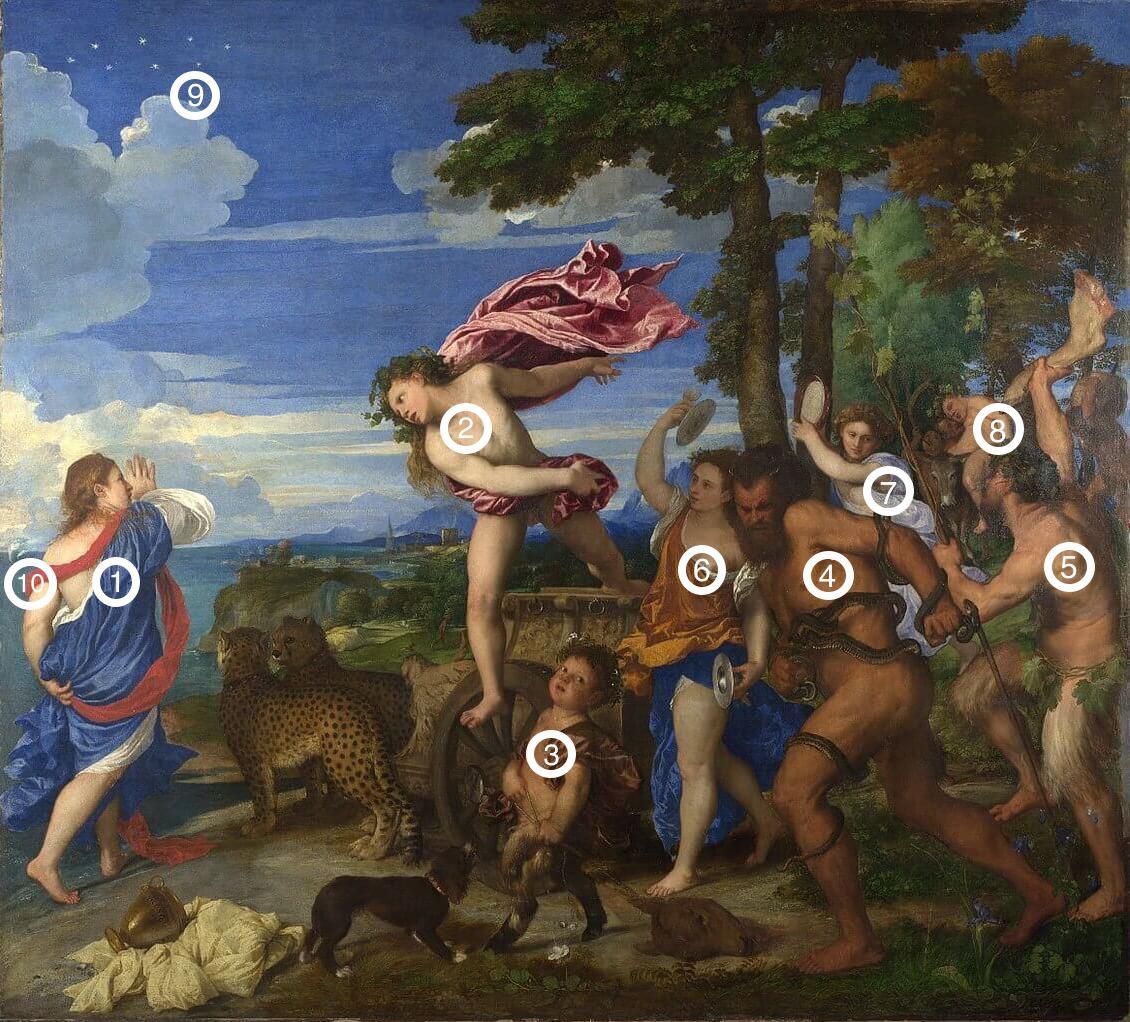
Bacchus and Ariadne. Heroes and symbols in the painting by Titian
Contents:
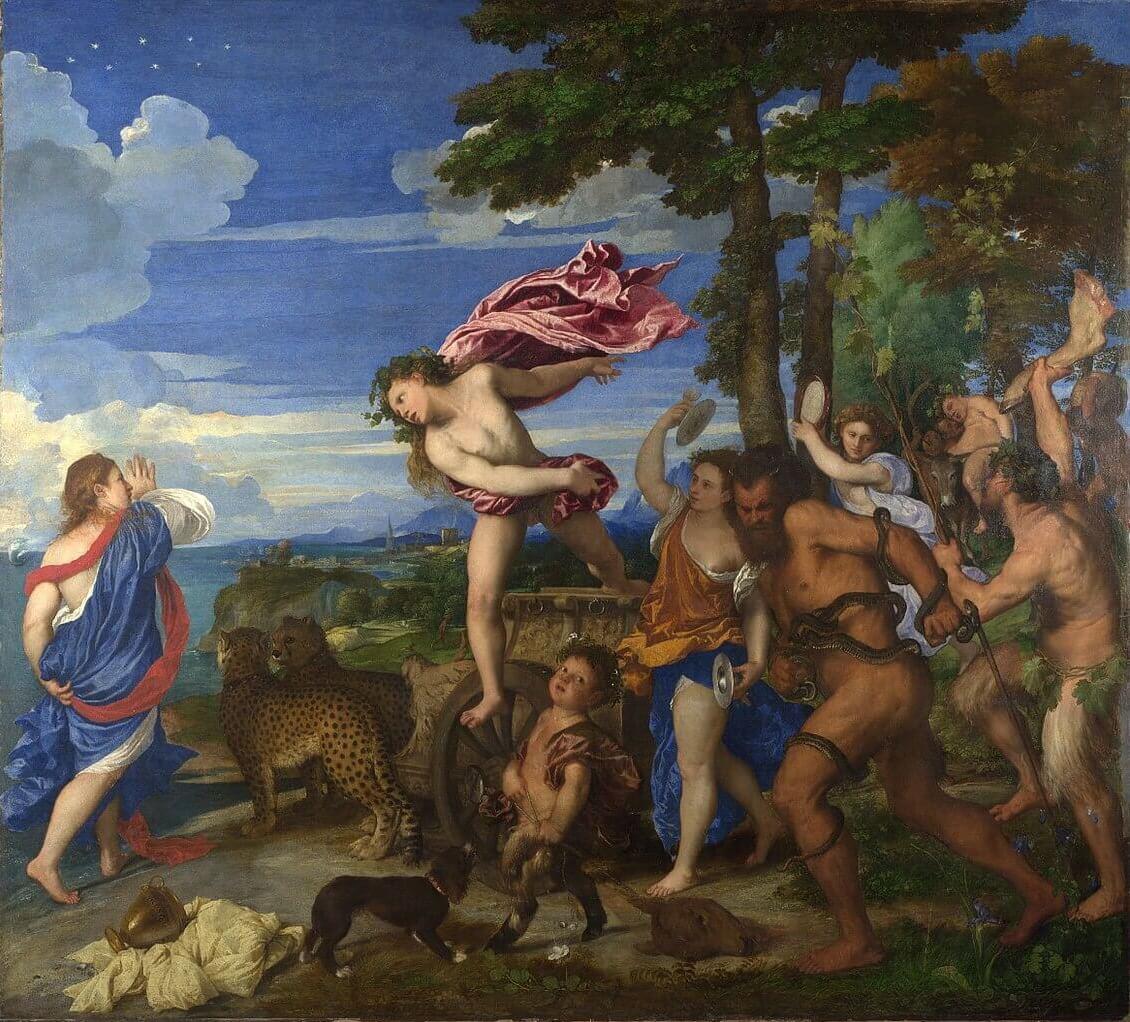
It is not so easy to enjoy a picture painted on a mythological plot. After all, for a start it is important to understand its heroes and symbols.
Of course, we all heard who Ariadne is and who Bacchus is. But they may have forgotten why they met. And who are all the other heroes in Titian's painting.
Therefore, I propose, for a start, to disassemble the picture "Bacchus and Ariadne" brick by brick. And only then enjoy its picturesque virtues.
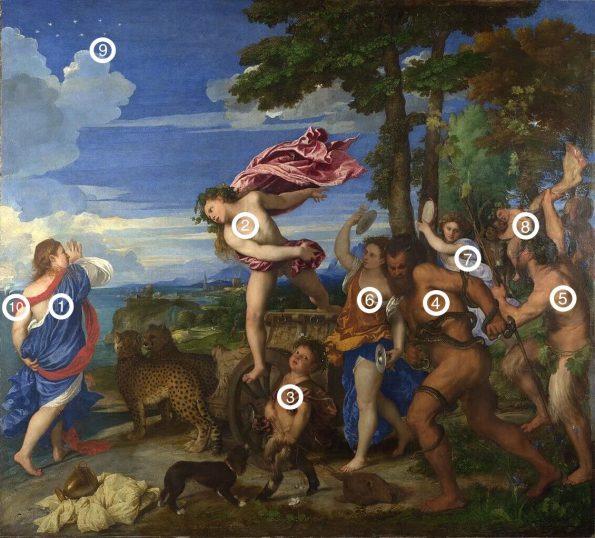
1. Ariadne.
Daughter of the Cretan king Minos. And the Minotaur is her twin brother. They don't look alike, but they are the same.
The Minotaur, unlike his sister, was a monster. And every year he ate 7 girls and 7 boys.
It is clear that the inhabitants of Crete are tired of this. They called on Theseus for help. He dealt with the Minotaur in the labyrinth in which he lived.
But it was Ariadne who helped him get out of the labyrinth. The girl could not resist the masculinity of the hero and fell in love.
She gave her beloved a ball of thread. By a thread, Theseus got out of the labyrinth.
After that, the young couple fled to the island. But for some reason, Theseus quickly lost interest in the girl.
Well, apparently at first he couldn't help but repay her gratitude for her help. But then I realized that I could not love.
He left Ariadne alone on the island. Here is such deceit.
2. Bacchus
He is Dionysus. He is Bacchus.
God of winemaking, vegetation. And also the theatre. Maybe that's why his attack on Ariadne is so theatrical and mannered? No wonder the girl recoiled so.
Bacchus actually saved Ariadne. Desperate to be abandoned by Theseus, she was ready to commit suicide.
But Bacchus saw her and fell in love. And unlike the treacherous Theseus, he decided to marry a girl.
Bacchus was the favorite son of Zeus. After all, he himself endured it in his thigh. Therefore, he could not refuse him, and made his wife immortal.
Bacchus is followed by his cheerful retinue. Bacchus was famous for the fact that passing by, he saved people from everyday troubles and made them feel the joy of life.
No wonder that his retinue was all the time in such an ecstasy of fun.
3. Pan
The boy Pan is the God of shepherding and cattle breeding. Therefore, he pulls the severed head of a calf or a donkey behind him.
The earthly mother abandoned him, afraid of his appearance at birth. Father Hermes carried the baby to Olympus.
The boy really liked Bacchus, because he danced and had fun without interruption. So he got into the retinue of the God of winemaking.
A cocker spaniel barks at the pan boy. This dog can also often be seen in the retinue of Bacchus. Apparently, the forest gang loves this pet for its cheerful disposition.
4. Strong with a snake
The Silenes were the children of Satyrs and Nymphs. They didn't get goat legs from their fathers. The beauty of their mothers interrupted this gene. But often Silenus is depicted with increased hairiness.
This one is not hairy at all. Apparently the mother nymph was especially good.
He also looks a bit like Laokon. This wise man persuaded the inhabitants of Troy not to bring the Trojan horse into the city. For this, the Gods sent huge snakes to him and his sons. They strangled them.
In fact, even in the texts of the ancient Roman poets, the Silenes were often described as naked and entwined with snakes. It's kind of like decoration, merging with nature. After all, they are forest dwellers.
5. Strong hairy
This Silenus apparently had the genes of the Satyr-papa more powerful. Therefore, goat hair thickly covers his legs.
Above his head he shakes a calf leg. Pier anyway. Leaves instead of clothes. Quite to the face of a forest creature.
6 and 7. Bacchae
By the name it is already clear that these ladies were ardent admirers of Bacchus. They accompanied him to numerous feasts and orgies.
Despite their cuteness, these girls were bloodthirsty. It was they who once tore poor Orpheus to pieces.
He sang a song about the gods, but forgot to mention Bacchus. For which he paid from his devoted companions.
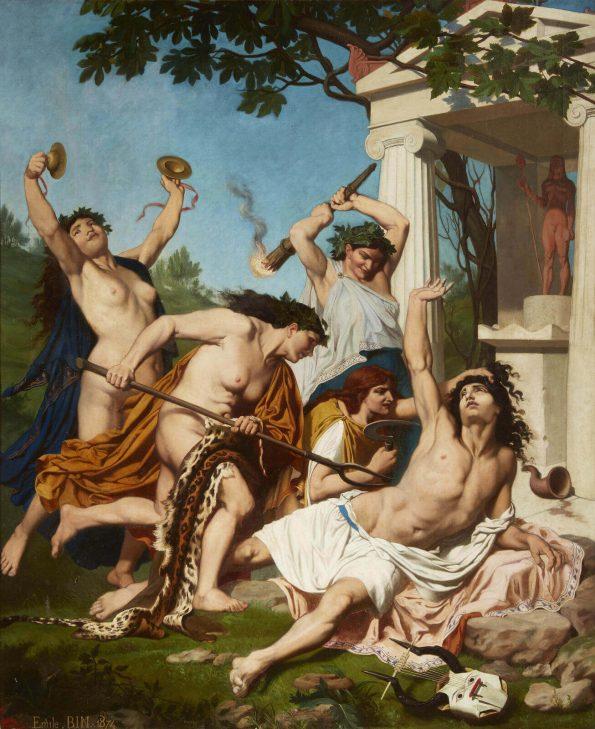
8. Drunk Silenus
Silenus is perhaps the most popular character from Bacchus' retinue. Judging by his appearance, he stays the longest in the retinue of the God of revelry.
He's in his 50s, overweight, and always drunk. So drunk that he's almost unconscious. He was put on a donkey and supported by other satyrs.
Titian depicted him behind the procession. But other artists often depicted him in the foreground, next to Bacchus.
Here at Vasari drunken, flabby Silenus sits at the feet of Bacchus, unable to tear himself away from the jug of wine.
Read more about this in the article “Radishchev Museum in Saratov. 7 paintings worth seeing.
site “Diary of painting. In each picture there is a story, a fate, a mystery.”
"data-medium-file="https://i0.wp.com/www.arts-dnevnik.ru/wp-content/uploads/2016/09/image-65.jpeg?fit=489%2C600&ssl=1″ data-large-file="https://i0.wp.com/www.arts-dnevnik.ru/wp-content/uploads/2016/09/image-65.jpeg?fit=489%2C600&ssl=1" loading ="lazy" class="wp-image-4031 size-full" title="Bacchus and Ariadne. Heroes and symbols in the painting by Titian” src=”https://i2.wp.com/arts-dnevnik.ru/wp-content/uploads/2016/09/image-65.jpeg?resize=489%2C600&ssl=1″ alt="Bacchus and Ariadne. Heroes and symbols in the painting by Titian" width="489" height="600" data-recalc-dims="1"/>
9. Constellation "Crown"
At the request of Bacchus, Hephaestus, the blacksmith god, made a crown for Ariadne. It was a wedding present. It was this crown that turned into a constellation.
Titian portrayed him really in the form of a crown. The real constellation is not just called the "Crown". On the one hand, it does not close into a ring.
This constellation can be observed throughout Russia. It is best seen in June.
10. Theseus' ship
A barely noticeable boat on the left of the picture belongs to the same Theseus. He irrevocably leaves poor Ariadne.
The picturesque wisdom of the painting by Titian
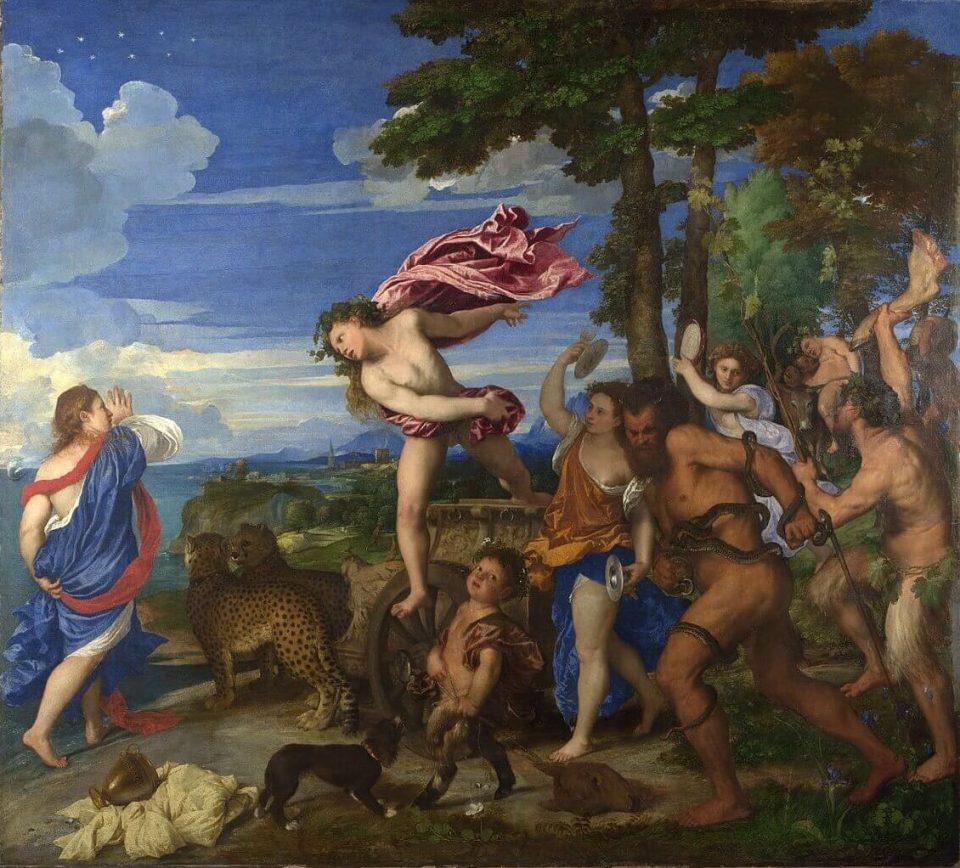
Now, when the characters are all deciphered, it is possible to make out the picturesque merits of the picture. Here are the most important ones:
1. Dynamics
Titian showed the figure of Bacchus in dynamics, "freezing" him in a jump from a chariot. This is a great innovation for Renaissance. Prior to this, the heroes often just stood or sat.
This flight of Bacchus somehow reminded me of "The Boy Bitten by a Lizard" Caravaggio. It was written 75 years after Titian's Bacchus and Ariadne.
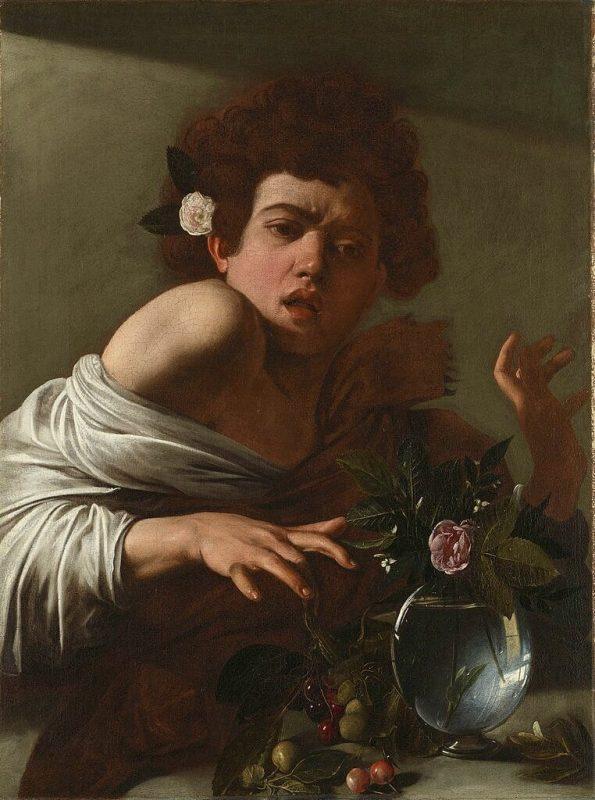
And only after Caravaggio this innovation will take root. And the dynamics of the figures will be the most important attribute of the Baroque Era (17th century).
2. Colour
Look at Titian's bright blue sky. The artist used ultramarine. For that time - a very expensive paint. It fell in price only at the beginning of the 19th century, when they learned how to produce it on an industrial scale.
But Titian painted a picture commissioned by the Duke of Ferrara. He apparently gave money for such a luxury.

3. Composition
The composition Titian built is also interesting.
The picture is divided diagonally into two parts, two triangles.
The upper left part is the sky and Ariadne in a blue robe. The lower right part is a green-yellow palette with trees and forest deities.
And between these triangles is Bacchus, like a brace, with a fluttering pink cape.
Such a diagonal composition, also an innovation of Titian, will be almost the main type of composition of all artists of the Baroque era (100 years later).
4. Realism
Notice how realistically Titian depicted the cheetahs harnessed to Bacchus' chariot.
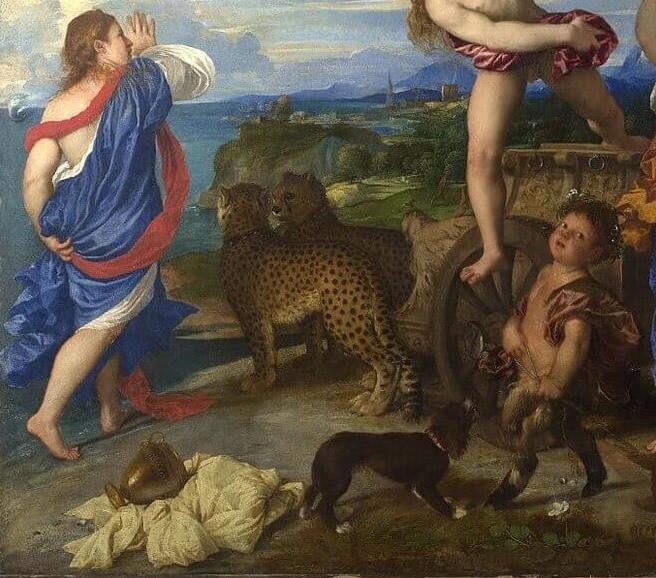
This is very surprising, because at that time there were no zoos, much less encyclopedias with photographs of animals.
Where did Titian see these animals?
I can assume that he saw sketches of travelers. Still, he lived in Venice, for which foreign trade was the main thing. And there were a lot of people traveling in this city.
***
This unusual story of love and betrayal was written by many artists. But it was Titian who told it in a special way. Making it bright, dynamic and exciting. And we only had to try a little to reveal all the secrets of the masterpiece of this picture.
Read about another masterpiece of the master in the article "Venus of Urbino. 5 surprising facts about the painting by Titian.
***
Comments other readers see below. They are often a good addition to an article. You can also share your opinion about the painting and the artist, as well as ask the author a question.
English version of the article
Leave a Reply